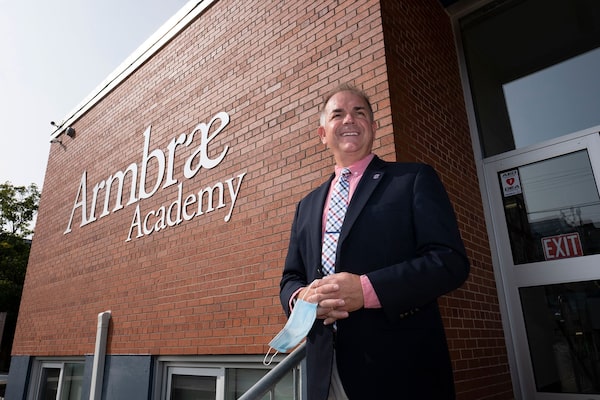
Armbrae Academy head of school Stephen Clarke stands at the main campus of the Halifax private school.Ted Pritchard/The Globe and Mail
Even after school started for many students across the country in the first week of September, Stephen Clarke’s phone was still ringing with requests from parents wondering if his school, Armbrae Academy, had room.
“We had one call after parents took their kids to public school and were uncomfortable about what they experienced [regarding physical distancing] and called to see if we had space,” Mr. Clarke says. “We [had] only been in school for a day and a half and we had quite a few people inquiring about the programming here.”
After schools were ordered to stay closed indefinitely last spring to avoid the spread of the COVID-19 virus, Mr. Clarke, head of school at Armbrae Academy, an independent school in Halifax, N.S., came up with a way to keep his students far apart when the school was allowed to reopen. Armbrae leased 8,000 square feet from a Synagogue down the street.
“There was a Hebrew School in that space that wasn’t currently being used so there are five classrooms, a gymnasium that we’ll use as a multipurpose space, a mini kitchen and lots of space for our students,” Mr. Clarke says.
Private and independent schools around the country say they have access to these kinds of options – such as leasing more space, providing the latest technology for online learning and funds for extra staff – because of their deeper pockets, compared with their public-school counterparts.

Mr. Clarke says he thinks some parents are turning to independent schools because they have 'more freedom to expand.'Ted Pritchard/The Globe and Mail
As well, many of these schools already had small class sizes, which were well within the public-health guidelines, so they had an easier time implementing safety protocols for in-class learning and physical distancing. All of which is attractive to parents who want to see their children back in the classroom but are concerned about the continuing pandemic.
“I think public schools are in a tough situation as they can’t really grow beyond their spaces, so I think people are looking at independent schools because we have more freedom to expand and find other spaces and socially distance a bit more easily,” Mr. Clarke says.
Private schools are also not bound by the same board recommendations and regulations as the public system, which, in many provinces, didn’t release their plans for reopening until a few weeks before schools were scheduled to reopen.
“We did have a lot of interest over the summer because we committed to being open,” explains Mr. Clarke. “We didn’t wait for the public systems to have our reopening plans, we’ve had them up on our website for a couple of months, so I think that drew some interest.”

To increase its capacity under physical distancing restrictions, Armbrae leased space at a nearby synagogue.Ted Pritchard/The Globe and Mail
At Stratford Hall School in Vancouver, in-class learning began in early September as well, but Jennifer Gunasekera, the school’s enrolment manager, says they had their students involved with online learning only two weeks after the country’s students were ordered to stay home.
“Resources were easily put online… we set up families and teachers with the technology they needed and by April 1 we were able to be fully online,” she explains.
Being one of the few schools in Canada that offer an International Baccalaureate program from Kindergarten to Grade 12, Stratford Hall fields many queries from interested families every year and the pandemic hasn’t changed that, says Ms. Gunasekera. But what has changed in the last six months, “are the questions that we’re being asked by families.”
“They want to know about our safety protocols, distancing and what our online programming looks like,” she explains. “And again, having the resources to physically distance, installing Plexiglass immediately, having all the necessary PPE [personal protective equipment] available to staff and students, just allows us to deliver a program that is satisfactory to families.”
Some independent and private schools offer a boarding-school option, which adds an extra layer of required physical-distancing measures, such as the protocols in place at Athol Murray College of Notre Dame in Wilcox, Sask.
“We have [fewer] students in the rooms, we’ve assigned sinks and showers to these rooms, there are no buffet lines at meal times… and all of this has been vetted through public health,” explains Robert Palmarin, the school’s president and director of education.
But “inquiries are still strong,” says Mr. Palmarin, especially for the school’s hockey programs. Notre Dame has 11 hockey teams and attracts students from all over the world, but for some, as is the case for the school’s Russian students, “they’re having difficulty getting out of the country so we’re having to do remote learning with those students until they can get here,” he adds.
All schools are having to adapt in some way to ensure the health and safety of students, staff and the general public, but the robust budget of private schools is showing itself to be a game changer for some families.
Back at Armbrae Academy, Mr. Clarke isn’t sure if his phone will continue to ring with calls from parents who are looking to make the jump from public to private school, but right now the shift is tangible.
“There’s no question, we are definitely being approached by people who, otherwise, wouldn’t have considered us,” he says.